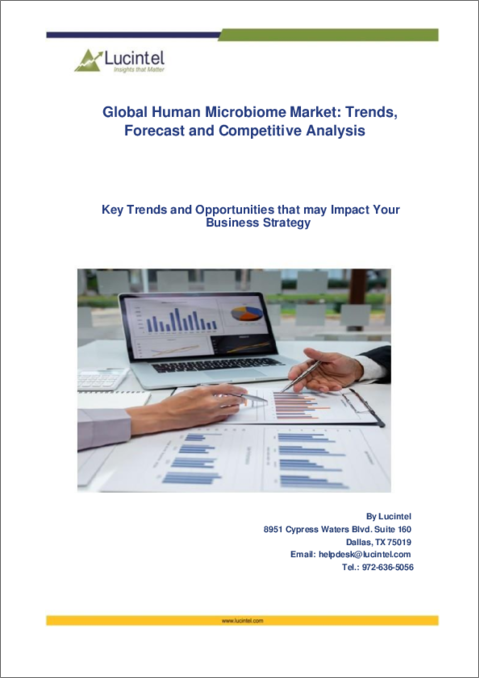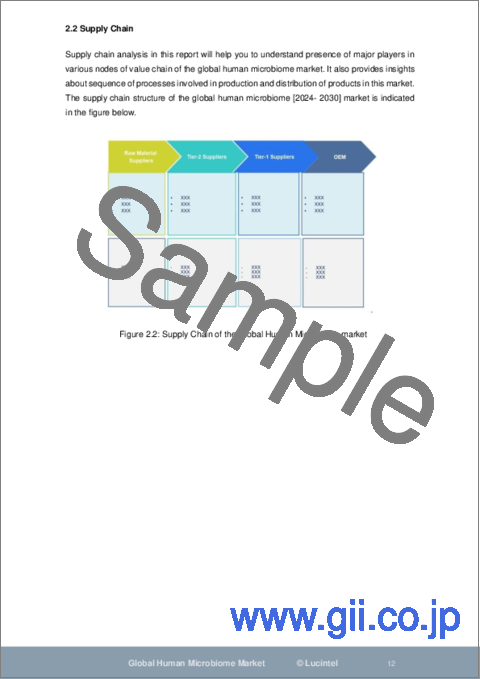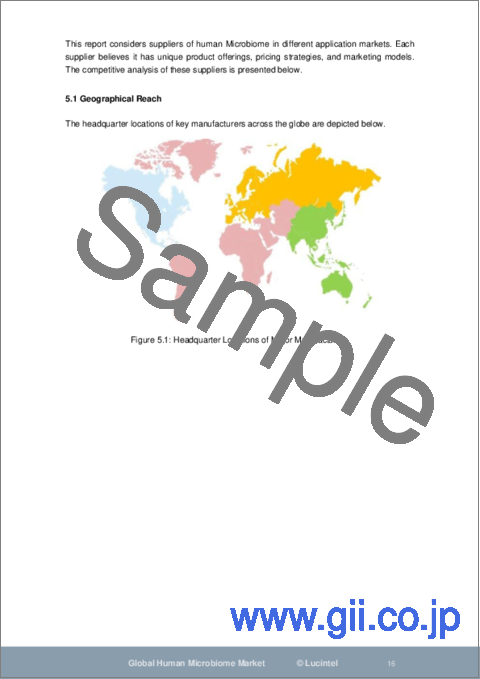|
|
市場調査レポート
商品コード
1448495
ヒトマイクロバイオーム市場:動向、予測、競合分析【2024-2030年】Human Microbiome Market: Trends, Forecast and Competitive Analysis [2024-2030] |
||||||
カスタマイズ可能
適宜更新あり
|
|||||||
| ヒトマイクロバイオーム市場:動向、予測、競合分析【2024-2030年】 |
|
出版日: 2024年02月27日
発行: Lucintel
ページ情報: 英文 150 - page report
納期: 3営業日
|
全表示
- 概要
- 目次
ヒトマイクロバイオーム市場の動向と予測
世界のヒトマイクロバイオーム市場は、2024~2030年のCAGRが17.8%で、2028年までに推定25億米ドルに達すると予測されます。この市場の主要促進要因は、ヒトマイクロバイオーム療法への注目の高まりと、メタゲノミクスと次世代シーケンサーにおける技術進歩の拡大です。世界のヒトマイクロバイオーム市場の将来は、医療産業における機会によって有望視されています。
ヒトマイクロバイオーム市場の新たな動向
業界の力学に直接的な影響を与える新たな動向には、がん治療への細菌マイクロバイオームの利用や、肥満治療への次世代プロバイオティクス微生物由来の分子の導入などがあります。
ヒトマイクロバイオーム市場洞察
- Lucintelは、健康への関心の高まり、栄養・食事と健康の関係に対する意識の高まり、乳製品やその他の食品へのプロバイオティクス市場の浸透の高まりにより、プロバイオティクスが予測期間中最大のセグメントであり続けると予測しています。
- 感染症は、抗生物質の使用が自然細菌叢に及ぼす悪影響(細菌叢の乱れなど)に対する認識が高まり、感染症に対する特定の細菌を標的とした治療法の必要性が浮き彫りになっているため、予測期間中も最大の疾患タイプであり続けると考えられます。
- 北米は、生活習慣病の罹患率の増加、予防医療に対する意識の高まり、マイクロバイオーム研究のための資金提供の可能性、プロバイオティクス製品の受け入れ拡大により、予測期間中も最大地域であり続けると考えられます。アジア太平洋は、ライフスタイルの変化による慢性疾患の増加とヒトマイクロバイオーム治療アプローチへの関心の高まりにより、予測期間中最も高い成長が見込まれます。
よくある質問
Q1.市場規模は:
回答:世界のヒトマイクロバイオーム市場は、2028年までに推定25億米ドルに達すると予想されています。
Q2.市場の成長予測は:
回答:ヒトマイクロバイオーム市場は、2024~2030年にかけてCAGR 17.8%で成長する見込みです。
Q3.市場の成長に影響を与える主要促進要因は:
回答:この市場の主要促進要因は、ヒトマイクロバイオーム治療への注目の高まりと、メタゲノミクスと次世代シーケンサーにおける技術進歩です。
Q4.ヒトマイクロバイオームの主要用途または最終用途産業は何ですか?
回答:治療と診断がヒトマイクロバイオームの主要用途です。
Q5.ヒトマイクロバイオーム市場の新たな動向は?
回答:業界の力学に直接的な影響を与える新たな動向としては、がん治療への細菌マイクロバイオームの利用、肥満治療への次世代プロバイオティクス微生物由来の分子の採用などがあります。
Q6.ヒトマイクロバイオームの主要企業はどこですか?
回答:ヒトマイクロバイオームの主要企業は以下の通りです:
- Enterome
- Seres Therapeutics
- 4D Pharma
- DuPont
- Vedanta Biosciences
- Osel
- Merck & Co.
- Second Genome
- Metabiomics Corporation
Q7.ヒトマイクロバイオーム製品セグメントで今後最も大きくなるのは?
回答:Lucintelは、健康への関心の高まり、栄養・食事と健康との関係に対する意識の高まり、乳製品やその他の食品へのプロバイオティクス市場の浸透の高まりから、予測期間中、プロバイオティクスが最大の製品セグメントであり続けると予測しています。
質問8:ヒトマイクロバイオーム市場において、今後5年間で最大になると予想される地域はどこですか?
回答:北米が引き続き最大で、アジア太平洋が今後5年間で最も高い成長を遂げると予想されます。
Q9.レポートのカスタマイズは可能か?
回答:はい、Lucintelは追加費用なしで10%のカスタマイズを記載しています。
目次
第1章 エグゼクティブサマリー
第2章 市場の背景と分類
- イントロダクション、背景、分類
- サプライチェーン
- 業界の促進要因と課題
第3章 2018~2030年の市場動向と予測分析
- マクロ経済の動向と予測
- 世界のヒトマイクロバイオーム市場の動向と予測
- 製品別の世界のヒトマイクロバイオーム市場
- プレバイオティクス
- プロバイオティクス
- 食品
- 医療用食品
- 薬剤
- 疾患タイプ別の世界のヒトマイクロバイオーム市場
- 感染性
- 代謝/内分泌
- がん
- 血液
- 神経系
- 研究技術別の世界のヒトマイクロバイオーム市場
- プロテオミクス
- メタボロミクス
- ゲノミクス
- 用途別の世界のヒトマイクロバイオーム市場
- 治療
- 診断
第4章 地域別の市場動向と予測分析
- 地域別の世界のヒトマイクロバイオーム市場
- 北米のヒトマイクロバイオーム市場
- 欧州のヒトマイクロバイオーム市場
- アジア太平洋のヒトマイクロバイオーム市場
- その他地域のヒトマイクロバイオーム市場
第5章 競合の分析
- 製品ポートフォリオ分析
- 市場シェア分析
- 地理的範囲
- ポーターのファイブフォース分析
第6章 成長機会と戦略的分析
- 成長機会の分析
- 製品別の世界のヒトマイクロバイオーム市場の成長機会
- 疾患タイプ別の世界のヒトマイクロバイオーム市場の成長機会
- 研究技術別の世界のヒトマイクロバイオーム市場の成長機会
- 用途別の世界のヒトマイクロバイオーム市場の成長機会
- 地域別の世界のヒトマイクロバイオーム市場の成長機会
- 世界のヒトマイクロバイオーム市場における新たな動向
- 戦略的分析
- 新製品の開発
- 世界のヒトマイクロバイオーム市場の能力拡大
- 世界のヒトマイクロバイオーム市場における合併、買収、合弁事業
第7章 有力企業の企業プロファイル
- Enterome
- Seres Therapeutics
- 4D Pharma
- DuPont
- Vedanta Biosciences
- Osel
- Yakult Hoshna
- Merck & Co
- Second Genome
- Metabiomics Corporation .
Human Microbiome Market Trends and Forecast
The future of the global human microbiome market looks promising with opportunities in the healthcare industry. The global human microbiome market is expected to reach an estimated $2.5 billion by 2028 with a CAGR of 17.8% from 2024 to 2030.The major drivers for this market are increasing focus on human microbiome therapies and growing technological advancements in metagenomics and next-generation sequencing.
Emerging Trends in the Human Microbiome Market
Emerging trends, which have a direct impact on the dynamics of the industry, include usage of bacterial microbiome for cancer treatment and introduction of next-generation probiotic microbiota-derived molecules for treatment of obesity.
A total of 119 figures / charts and 99 tables are provided in this 209-page report to help in your business decisions. A sample figure with some insights is shown below.
Human Microbiome Market by Segment
In this market, therapeutics is the largest application market, whereas probiotics is the largest market by product type.
The study includes trends and forecast for the global human microbiome market by product, disease type, research technology, application, and region as follows:
Human Microbiome By Product [Value ($M) from 2018 to 2030]:
- Prebiotics
- Probiotics
- Food
- Medical Food
- Drugs
Human Microbiome By Disease Type [Value ($ Million) from 2018 to 2030]:
- Infectious
- Metabolic/ Endocrine
- Cancer
- Blood
- Neurological
Human Microbiome By Research Technology [Value ($ Million) from 2018 to 2030]:
- Proteomics
- Metabolomics
- Genomics
Human Microbiome By Application [Value ($ Million) from 2018 to 2030]:
- Therapeutics
- Diagnostics
Human Microbiome By Region [Value ($ Million from 2018 to 2030]:
- North America
- US
- Canada
- Mexico
- Europe
- United Kingdom
- Germany
- France
- Italy
- Spain
- APAC
- China
- Japan
- India
- ROW
- Brazil
List of Human Microbiome Companies
Companies in the market compete on the basis of product quality offered. Major players in this market focus on expanding their manufacturing facilities, R&D investments, infrastructural development, and leverage integration opportunities across the value chain. With these strategies human microbiome companies cater increasing demand, ensure competitive effectiveness, develop innovative products & technologies, reduce production costs, and expand their customer base. Some of the human microbiome companies profiled in this report include.
- Enterome
- Seres Therapeutics
- 4D Pharma
- DuPont
- Vedanta Biosciences
- Osel
- Merck & Co.
- Second Genome
- Metabiomics Corporation
Human Microbiome Market Insights
- Lucintel forecasts that probiotics will remain the largest segment over the forecast period due to increasing health concerns; growing awareness of the relationship between nutrition, diet, and health; and increasing penetration of the probiotic market in dairy and other foods.
- Infectious disease will remain the largest disease type over the forecast period due to increasing cognizance of the negative effects of antibiotic use on the natural flora (such as disruptions), which has highlighted the need for specific bacterial-targeted therapies for infectious diseases.
- North America will remain the largest region over the forecast period due to increasing incidence of lifestyle-related diseases, rising awareness of preventive healthcare, availability of funding for microbiome research, and growing acceptance of probiotic products. APAC is expected to witness the highest growth over the forecast period due rising chronic diseases caused by changes in lifestyle and growing interest in human microbiome treatment approaches.
Features of the Human Microbiome Market
- Market Size Estimates: Global human microbiome market size estimation in terms of value ($M) shipment.
- Trend and Forecast Analysis: Market trends (2018-2023) and forecast (2024-2030) by various segments.
- Segmentation Analysis: Global human microbiome market size by product, disease type, research technology, application, and region in terms of value.
- Regional Analysis: Global human microbiome market breakdown by North America, Europe, Asia Pacific, and Rest of the World.
- Growth Opportunities: Analysis of growth opportunities in different product, disease type, research technology, application, and region for the global human microbiome market.
- Strategic Analysis: This includes M&A, new product development, and competitive landscape of the global human microbiome market.
- Analysis of competitive intensity of the industry based on Porter's Five Forces model.
FAQ
Q1. What is the human microbiome market size?
Answer:The global human microbiome market is expected to reach an estimated $2.5 billion by 2028.
Q2. What is the growth forecast for human microbiome market?
Answer:The human microbiome market is expected to grow at a CAGR of 17.8% from 2024 to 2030.
Q3. What are the major drivers influencing the growth of the human microbiome market?
Answer: The major drivers for this market are increasing focus on human microbiome therapies and technological advancements in metagenomics and next-generation sequencing.
Q4. What are the major applications or end use industries for human microbiome?
Answer:Therapeutics and Diagnostics are the major applications for human microbiome
Q5. What are the emerging trends in human microbiome market?
Answer:Emerging trends, which have a direct impact on the dynamics of the industry, include usage of bacterial microbiome for cancer treatment and introduction of next-generation probiotic microbiota-derived molecules for treatment of obesity.
Q6. Who are the key human microbiome companies?
Answer:Some of the key human microbiome companies are as follows:
- Enterome
- Seres Therapeutics
- 4D Pharma
- DuPont
- Vedanta Biosciences
- Osel
- Merck & Co.
- Second Genome
- Metabiomics Corporation
Q7.Which human microbiome product segment will be the largest in future?
Answer: Lucintel forecasts that probiotics will remain the largest product segment over the forecast period due to increasing health concerns; growing awareness of the relationship between nutrition, diet, and health; and increasing penetration of the probiotic market in dairy and other foods.
Q8: In human microbiome market, which region is expected to be the largest in next 5 years?
Answer:North America will remain the largest region and Asia Pacific expected to witness the highest growth over next 5 years.
Q9. Do we receive customization in this report?
Answer:Yes, Lucintel provides 10% Customization Without any Additional Cost.
This report answers following 11 key questions
- Q.1 What are some of the most promising growth opportunities for the global human microbiome market by product (prebiotics, probiotics, food, medical food, and drugs), disease type (infectious, metabolic/endocrine, cancer, blood, and neurological), research technology (proteomics, metabolomics, and genomics), application (therapeutics and diagnostics), and region (North America, Europe, Asia Pacific, and the Rest of the World)?
- Q.2 Which segments will grow at a faster pace and why?
- Q.3 Which region will grow at a faster pace and why?
- Q.4 What are the key factors affecting market dynamics? What are the drivers and challenges of the global human microbiome market?
- Q.5 What are the business risks and threats to the global human microbiome market?
- Q.6 What are the emerging trends in this human microbiome market and the reasons behind them?
- Q.7 What are some changing demands of customers in the human microbiome market?
- Q.8 What are the new developments in the human microbiome market? Which companies are leading these developments?
- Q.9 Who are the major players in the human microbiome market? What strategic initiatives are being implemented by key players for business growth?
- Q.10 What are some of the competitive products and processes in the human microbiome market, and how big of a threat do they pose for loss of market share via material or product substitution?
- Q.11 What M&A activities did take place in the last five years in the global human microbiome market?
Table of Contents
1. Executive Summary
2. Market Background and Classifications
- 2.1: Introduction, Background, and Classifications
- 2.2: Supply Chain
- 2.3: Industry Drivers and Challenges
3. Market Trends and Forecast Analysis from 2018 to 2030
- 3.1: Macroeconomic Trends and Forecast
- 3.2: Global Human Microbiome Market Trends and Forecast
- 3.3: Global Human Microbiome Market by Product
- 3.3.1: Prebiotics
- 3.3.2: Probiotics
- 3.3.3: Food
- 3.3.4: Medical Food
- 3.3.5: Drugs
- 3.4: Global Human Microbiome Market by Disease Type
- 3.4.1: Infectious
- 3.4.2: Metabolic/Endocrine
- 3.4.3: Cancer
- 3.4.4: Blood
- 3.4.5: Neurological
- 3.5: Global Human Microbiome Market by Research Technology
- 3.5.1: Proteomics
- 3.5.2: Metabolomics
- 3.5.3: Genomics
- 3.6: Global Human Microbiome Market by Application
- 3.6.1: Therapeutics
- 3.6.2: Diagnostics
4. Market Trends and Forecast Analysis by Region
- 4.1: Global Human Microbiome Market by Region
- 4.2: North American Human Microbiome Market
- 4.2.1: Market by Product: Prebiotics, Probiotics, Food, Medical Food, and Drugs
- 4.2.2: Market by Disease Type: Infectious, Metabolic/Endocrine, Cancer, Blood, and Neurological
- 4.2.3: Market by Research Technology: Proteomics, Metabolomics, and Genomics
- 4.2.4: Market by Application: Therapeutics and Diagnostics
- 4.2.5: The US Human Microbiome Market
- 4.2.6: Canadian Human Microbiome Market
- 4.2.7: Mexican Human Microbiome Market
- 4.3: European Human Microbiome Market
- 4.3.1: Market by Product: Prebiotics, Probiotics, Food, Medical Food, and Drugs
- 4.3.2: Market by Disease Type: Infectious, Metabolic/Endocrine, Cancer, Blood, and Neurological
- 4.3.3: Market by Research Technology: Proteomics, Metabolomics, and Genomics
- 4.3.4: Market by Application: Therapeutics and Diagnostics
- 4.3.5: Human Microbiome Market of the United Kingdom
- 4.3.6: German Human Microbiome Market
- 4.3.7: French Human Microbiome Market
- 4.3.8: Italian Human Microbiome Market
- 4.3.9: Spanish Human Microbiome Market
- 4.4: APAC Human Microbiome Market
- 4.4.1: Market by Product: Prebiotics, Probiotics, Food, Medical Food, and Drugs
- 4.4.2: Market by Disease Type: Infectious, Metabolic/Endocrine, Cancer, Blood, and Neurological
- 4.4.3: Market by Research Technology: Proteomics, Metabolomics, and Genomics
- 4.4.4: Market by Application: Therapeutics and Diagnostics
- 4.4.5: Chinese Human Microbiome Market
- 4.4.6: Japanese Human Microbiome Market
- 4.4.7: Indian Human Microbiome Market
- 4.5: ROW Human Microbiome Market
- 4.5.1: Market by Product: Prebiotics, Probiotics, Food, Medical Food, and Drugs
- 4.5.2: Market by Disease Type: Infectious, Metabolic/Endocrine, Cancer, Blood, and Neurological
- 4.5.3: Market by Research Technology: Proteomics, Metabolomics, and Genomics
- 4.5.4: Market by Application: Therapeutics and Diagnostics
- 4.5.5: Brazilian Human Microbiome Market
5. Competitor Analysis
- 5.1: Product Portfolio Analysis
- 5.2: Market Share Analysis
- 5.3: Geographical Reach
- 5.4: Porter's Five Forces Analysis
6. Growth Opportunities and Strategic Analysis
- 6.1: Growth Opportunity Analysis
- 6.1.1: Growth Opportunities for the Global Human Microbiome Market by Product
- 6.1.2: Growth Opportunities for the Global Human Microbiome Market by Disease Type
- 6.1.3: Growth Opportunities for the Global Human Microbiome Market by Research Technology
- 6.1.4: Growth Opportunities for the Global Human Microbiome Market by Application
- 6.1.5: Growth Opportunities for the Global Human Microbiome Market by Region
- 6.2: Emerging Trends in the Global Human Microbiome Market
- 6.3: Strategic Analysis
- 6.3.1: New Product Development
- 6.3.2: Capacity Expansion of the Global Human Microbiome Market
- 6.3.3: Mergers, Acquisitions, and Joint Ventures in the Global Human Microbiome Market
7. Company Profiles of Leading Players
- 7.1: Enterome
- 7.2: Seres Therapeutics
- 7.3: 4D Pharma
- 7.4: DuPont
- 7.5: Vedanta Biosciences
- 7.6: Osel
- 7.7: Yakult Hoshna
- 7.8: Merck & Co
- 7.9: Second Genome
- 7.10: Metabiomics Corporation .




